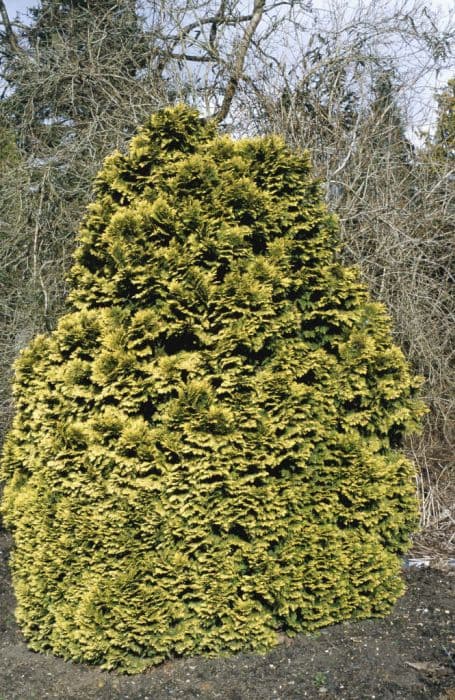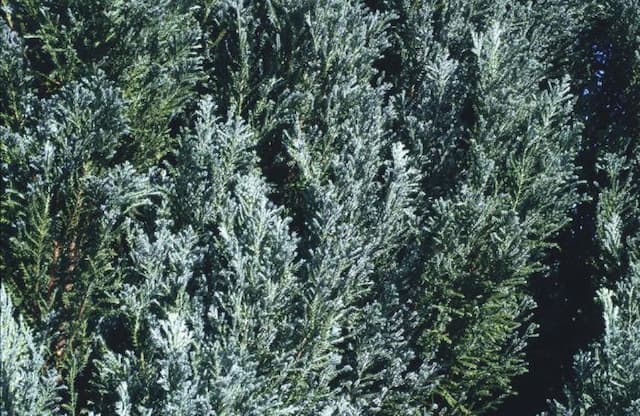Pfitzer Juniper Juniperus × pfitzeriana 'Pfitzeriana Aurea'

ABOUT
The plant commonly known as Pfitzer Juniper 'Pfitzeriana Aurea' typically presents as a dense, evergreen shrub. It is characterized by a spreading habit with branches that tend to arch gracefully. The foliage of this juniper cultivar is particularly appealing due to its vibrant golden-yellow color, especially on the new growth. As the needles mature, they may transition to a softer green hue, giving the plant a two-toned appearance that adds depth and interest. The needles themselves are slightly scale-like and closely appressed, adding texture to the overall look of the plant. The plant may produce berry-like cones that are small and inconspicuous, often with a blueish tint. These add an additional layer of visual interest, although they are not typically a prominent feature. Overall, the Pfitzer Juniper 'Pfitzeriana Aurea' is valued for its colorful and lush foliage that makes it a striking choice in landscapes for ground cover or as an accent plant.
About this plant
 Names
NamesSynonyms
Pfitzer Juniper, Gold Coast Juniper, Pfitzeriana Gold Juniper.
Common names
Juniperus × pfitzeriana 'Pfitzeriana Aurea'.
 Toxicity
ToxicityTo humans
Pfitzer juniper's toxicity to humans is generally considered low. However, ingesting any part of the plant can lead to stomach upset, including symptoms like nausea, vomiting, and diarrhea. Handling the plant may also cause skin irritation in sensitive individuals. It is advisable to avoid consuming any part of the pfitzer juniper and to wear gloves when handling this plant if you have sensitive skin.
To pets
Pfitzer juniper may also have low toxicity to pets. If a pet ingests parts of the plant, they might experience gastrointestinal upset, which could manifest as vomiting or diarrhea. While it is not considered highly toxic to pets, it's still best to prevent your animals from eating it as a precaution. If you suspect your pet has ingested pfitzer juniper and is showing symptoms, contact your veterinarian for advice.
 Characteristics
CharacteristicsLife cycle
Perennials
Foliage type
Evergreen
Color of leaves
Yellow-green
Height
4-5 feet (1.2-1.5 meters)
Spread
6-8 feet (1.8-2.4 meters)
Plant type
Shrub
Hardiness zones
4-9
Native area
Cultivar
Benefits
 General Benefits
General Benefits- Landscape enhancement: The plant offers aesthetic appeal with its bright golden foliage, which can brighten up garden landscapes and provide visual interest throughout the year.
- Drought resistance: Once established, it has good drought tolerance, reducing the need for frequent watering and maintenance.
- Erosion control: Its extensive root system helps to stabilize the soil, making it useful for controlling erosion on slopes and banks.
- Low maintenance: It requires minimal pruning and care once established, which is ideal for gardeners seeking low-maintenance landscaping options.
- Wildlife habitat: Provides cover and nesting sites for birds and other wildlife, enhancing biodiversity in the garden.
- Soil adaptability: Adapts to a wide range of soil types, from clay to sandy soils, as long as they are well-drained.
- Windbreak: Can be used as a windbreak or hedge, offering protection to more delicate plants and creating microclimates within the garden.
- Privacy screen: When planted in groups, it can form an effective privacy screen, blocking unwanted views and reducing noise pollution.
 Medical Properties
Medical PropertiesThis plant is not used for medical purposes.
 Air-purifying Qualities
Air-purifying QualitiesThis plant is not specifically known for air purifying qualities.
 Other Uses
Other Uses- Photography: The Golden Pfitzer Juniper, with its yellow-tinted foliage, can serve as a vibrant backdrop for outdoor portraiture or nature photography, adding a splash of color and texture to the composition.
- Windbreaks: Due to its dense growth habit, the Golden Pfitzer Juniper can be planted in rows to create effective windbreaks, helping reduce wind speed and protect more sensitive plants in the garden.
- Erosion Control: The plant's extensive root system helps to stabilize slopes and prevent soil erosion in landscapes that are prone to losing ground cover.
- Habitat Creation: The dense foliage of Golden Pfitzer Juniper provides cover and nesting sites for birds and small wildlife, creating a mini sanctuary in your yard.
- Noise Reduction: When used as a hedge or screening plant, the Golden Pfitzer Juniper can help dampen traffic noise or other undesirable sounds from the surrounding area.
- Seasonal Decorations: Branches of the Golden Pfitzer Juniper can be cut and used in wreaths, garlands, or other holiday decorations, offering a natural and fragrant element to seasonal decor.
- Topiary: With its adaptability to pruning, Golden Pfitzer Juniper is suitable for shaping into topiary forms, which can add a formal or whimsical touch to gardens and landscapes.
- Crafts: The wood and foliage of this juniper are sometimes used in craft projects, such as making small furniture, decorative items, or even scented sachets.
- Privacy Screening: The dense and spreading nature of the Golden Pfitzer Juniper makes it an excellent choice for homeowners seeking a natural and attractive privacy screen.
- Garden Contrast: Its bright foliage can be used to create dramatic contrast when planted alongside darker-leaved plants or in a rock garden, enhancing the aesthetic appeal of the space.
Interesting Facts
 Feng Shui
Feng ShuiThe Pfitzer juniper is not used in Feng Shui practice.
 Zodiac Sign Compitability
Zodiac Sign CompitabilityThe Pfitzer juniper is not used in astrology practice.
 Plant Symbolism
Plant Symbolism- Purification: Junipers are often associated with cleansing and purification rituals, believed to clear negative energy and guard against evil influences.
- Protection: The plant is thought to offer protection, with traditions of planting juniper near the front door to safeguard the home.
- Health: Historically, juniper has been used for its medicinal properties, symbolizing wellness and the healing of ailments.
- Endurance: As a plant that can thrive in harsh conditions, juniper symbolizes the ability to persevere and endure difficulties.
- Longevity: The longevity of juniper plants, which can live for hundreds of years, represents a long life and wisdom.
 Water
WaterThe Pfitzer Juniper should be watered regularly until it is well-established, generally for the first growing season. Once established, it's drought-resistant and requires watering only during prolonged dry spells. The deep watering method is ideal for this juniper, allowing water to seep slowly into the soil to reach the deeper roots. Approximately 2 gallons per week may be needed during hot or dry weather, while in cooler times, less frequent watering is necessary. Monitor the soil moisture and ensure that the plant is not sitting in waterlogged conditions, which can lead to root rot.
 Light
LightThe Pfitzer Juniper thrives in full sunlight and should be planted in a spot where it receives at least 6 hours of direct sun each day. Though it can tolerate partial shade, too little light can result in a less dense foliage and may impede growth. The brightest possible location will bring out the best color and form in this evergreen shrub.
 Temperature
TemperaturePfitzer Junipers are hardy and adaptable to various temperatures, tolerating a minimum of -20 degrees Fahrenheit and a maximum of around 100 degrees Fahrenheit. The ideal temperature range for the Pfitzer Juniper lies between 60 and 80 degrees Fahrenheit, but it can survive temperature fluctuations outside this range quite well.
 Pruning
PruningPfitzer Junipers benefit from pruning to maintain shape and encourage dense growth; it also prevents the center from becoming too woody. Prune in late winter or early spring before new growth begins. Lightly trim the tips of branches to shape the plant, but avoid heavy pruning, which can be difficult for the juniper to recover from. Pruning should be done annually or as needed to maintain its desired form.
 Cleaning
CleaningNot needed
 Soil
SoilThe Pfitzer Juniper prefers a well-draining soil mixture with a slight acidic to neutral pH of 6.0 to 7.0. A mix of equal parts garden soil, peat moss or compost, and coarse sand or perlite is ideal for facilitating good drainage and mimicking the plant's natural growing conditions.
 Repotting
RepottingPfitzer Junipers are slow-growing and do not require frequent repotting. It's generally recommended to repot these plants every 3 to 4 years to refresh the soil and expand the root space as needed.
 Humidity & Misting
Humidity & MistingPfitzer Junipers tolerate a wide range of humidity levels and do well in the natural outdoor humidity. They are not particular about high humidity and can thrive in average ambient conditions.
 Suitable locations
Suitable locationsIndoor
Not ideal for indoor growth; needs sun, well-drained soil.
Outdoor
Plant in sunny spot with well-drained soil; hardy, low maintenance.
Hardiness zone
4-9 USDA
 Life cycle
Life cycleThe common name of Juniperus × pfitzeriana 'Pfitzeriana Aurea' is Pfitzer Juniper. This plant begins its life as a seed, typically requiring a period of stratification to break dormancy before it germinates. Upon germination, the seedling grows into a juvenile plant exhibiting needle-like foliage, which gradually matures into adult foliage with scale-like leaves as it enters the vegetative stage. The mature Pfitzer Juniper starts the reproductive phase by producing small, inconspicuous flowers; males release pollen, while female cones develop into berry-like structures called juniper berries, containing seeds for the next generation. The evergreen shrub continues to grow and spread, often living for several decades, with a slow growth rate and a spreading habit. After reaching the end of its life cycle, the plant eventually declines and dies, where natural processes decompose it, returning nutrients to the soil and completing the cycle.
 Propogation
PropogationPropogation time
Late winter-early spring
The most popular method of propagating Juniperus × pfitzeriana 'Pfitzeriana Aurea', commonly known as Gold Coast Juniper, is through softwood cuttings. This is typically done during the late spring or early summer when the new growth is just beginning to harden and is still flexible. To propagate, cuttings of about 4 to 6 inches long are taken with a sharp, sterilized cutting tool. The lower end is dipped in rooting hormone to facilitate root development. Afterward, the cutting is placed in a well-draining potting mix, ensuring that at least two sets of leaf nodes are below the surface. The cutting should be kept in a warm environment with high humidity and indirect light until roots have established, which can take several weeks. Regular misting can help maintain the necessary humidity levels.









